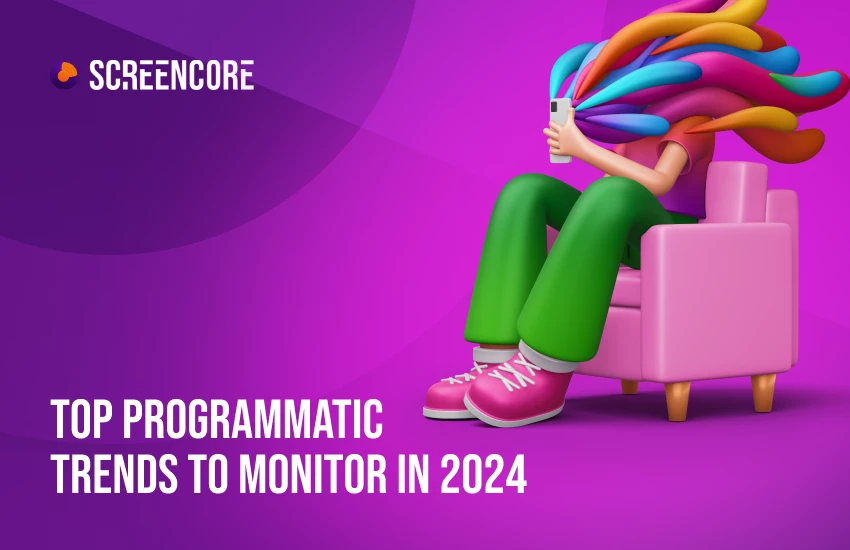Top Programmatic Trends to Monitor in 2024

Programmatic advertising continues to be a dominant force. According to the latest Dentsu Global Ad Spend Forecasts covering 58 global markets, advertising spending will expand by $33.0 billion in 2024 to reach $752.8 billion. This represents a 4.6% growth year-over-year for the ad industry – much faster than the pace seen in 2023 (+2.7% vs. 2022). So, the landscape promises even more innovation and change.
What will 2024 have in store for the programmatic industry? This article will explore key programmatic trends to watch as we usher in the new year.
Transparency
The transparency trend in programmatic advertising, especially in 2024, reflects a significant shift towards more open and accountable advertising practices. The focus on supply chain transparency and more efficient buying in programmatic will continue to be front and center for media buyers, especially given the global macroeconomic environment. Buyers will continue to scrutinise their supply route and the inventory itself.
Moreover, the advertising industry will likely strongly emphasise transparent data practices. Companies will be more upfront about collecting, using, and storing consumer data, driven by stricter privacy regulations like GDPR and CCPA. Screencore respects users' and customers' privacy and does everything possible to ensure it right now.
AI-Powered Creative Optimisation
The upcoming year is a landmark period in the advertising sector, particularly with the widespread application of generative AI models. This evolution will be prominently observed in programmatic advertising, where the primary aim is to enhance value, forge more engaging consumer experiences, and elevate efficiency and effectiveness.

AI will analyse user data and tailor ad creatives, ensuring each user sees the most relevant and engaging content. We predict that in 2024, AI will analyse user data and tailor ad creatives on the fly, ensuring that each user sees the most relevant and engaging content.
Third-Party Cookies Phase-Out
As we approach 2024, the digital advertising landscape is on the cusp of a significant transformation with the phase-out of third-party cookies. The phase-out of third-party cookies represents a seismic shift in user data collection and use. This transition necessitates more responsible and user-centric data practices.
The decline of third-party cookies, long the backbone of online advertising strategies, signifies a shift towards more privacy-conscious practices. Advertisers and marketers are now challenged to find new, innovative ways to gather insights and target audiences without compromising user privacy.
In 2024, we expect to see the rise of alternative strategies that focus on first-party data, where information is collected directly from user interactions with a brand's platforms. This approach aligns with stricter privacy standards and offers the potential for more direct and meaningful engagement with consumers.
The Boom of CTV Advertising
As more consumers adopt streaming services, brands follow suit, and programmatic CTV advertising is expected to experience substantial growth. In 2023, CTV advertising spending in the United States is projected at 26.92 billion U.S. dollars, according to eMarketer. CTV ad spending is expected to grow to 43.59 billion U.S. dollars by 2026. This is because publishers and advertisers see huge potential in monetising streaming services.

Screencore is a platform focused on CTV and video content and we anticipate that CTV advertising will capitalise on its ability to offer highly targeted and measurable ad campaigns. Unlike traditional television advertising, CTV allows advertisers to use viewer data to deliver tailored content, making each ad more relevant to its audience. This relevance is expected to drive higher engagement rates and better ROI for advertisers.
Multichannel Programmatic Advertising
Relying on a single channel for programmatic marketing isn’t sustainable. Companies need to expand their horizons to stay competitive and reach the target audience effectively. It’s time to embrace a multi-channel approach.
Multichannel programmatic advertising enables brands to deliver a consistent message across various platforms, ensuring a cohesive and personalised user experience. The average consumer uses almost six touchpoints before making a purchase. Multichannel programmatic advertising will allow brands to create consistent, personalised messaging across various platforms.
First-Party Data
According to Medium, the impact of first-party data in 2024 encompasses the entire spectrum of digital marketing, from audience segmentation to customised content. In the face of tighter privacy regulations, first-party data becomes indispensable for precise, regulatory-compliant customer engagement.
The importance of first-party data is growing. In 2023, 73% of marketers reported relying more on first-party data due to privacy concerns. Marketers can leverage first-party data to tailor their campaigns to the nuanced preferences of their audience, ensuring high relevance and personalisation. This approach is not only compliant with data protection laws but also tends to result in higher ROI.
Final Thoughts About 2024
Next year is shaping to be a pivotal year for programmatic advertising, characterised by rapid technological advancements, a deeper focus on consumer privacy, the embrace of multichannel strategies, and a shift towards more interactive ad experiences. These trends will redefine digital advertising, presenting challenges and opportunities for advertisers and marketers worldwide.

